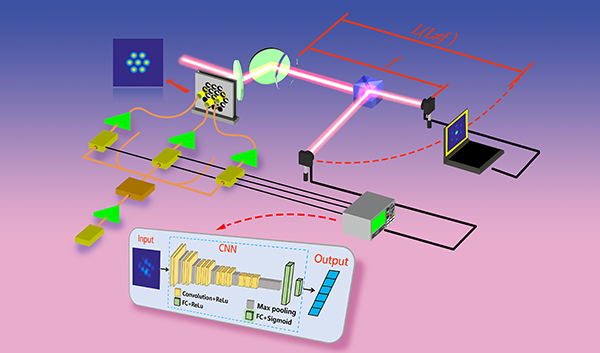Coherent beam combining (CBC) technology is an important technical approach to break through the brightness limitation of a single laser beam, and has become a frontier and hotspot of laser technology research. According to the aperture filling method, CBC can be classified into two categories: filled aperture combining and tiled aperture combining. Tiled aperture CBC achieves wavefront matching among beamlets through phase control, thus efficiently increases the emission aperture, compresses the far-field divergence angle, and improves the brightness.
In tiled aperture CBC system, the dynamic phase noise of each laser beam seriously affects the efficiency, energy concentration, and brightness of the combining system, and it is one of the key factors that limits the development of the combining system to high power and large array elements. In order to overcome the impact of dynamic phase noise, researchers have successively proposed various phase control methods, such as heterodyne detection, multi-dithering technique, single-frequency dithering technique, and stochastic parallel gradient descent algorithm, which have been effectively implemented to different types of CBC system. However, the above-mentioned phase control methods have a common problem: with the expansion of the combining channels and the enhancement of phase noise, the system control bandwidth would decrease to some degree, which leads to an increase in phase-locked residuals and a decrease in combining efficiency.
A research group from College of Advanced Interdisciplinary Studies, National University of Defense Technology has incorporated deep learning (DL) into tiled-aperture CBC systems for the first time, providing a new reference on solving the above-mentioned problem. The authors have shown that constructing a convolutional neural network (CNN), which can accurately reflect the relationship between the phase error and the measurable intensity distribution of the combined beam after pre-training, and then the phase noise could be directly compensated. Conventional phase control methods usually extract the phase control signals from the far-field intensity information of the combined beam. However, the introduction of DL brings a new technical challenge-there is no one-to-one correspondence between the far-field intensity distribution of the combined beam and the relative phases of the array elements, which may cause network failure due to data confliction. To overcome this challenge, the authors propose a method for training the CNN at the non-focal-plane to effectively extract phase information. The results show that the CNN trained at the non-focal-plane could reflect the phase distribution of the beam array at the source plane more accurately, and moreover, efficient and accurate compensation of dynamic phase noise could be achieved.
Furthermore, the DL-based phase control method has been tested by the CBC systems with 7-element and 19-element hexagonal arrays. Using key metrics (including Strehl ratio, fringe contrast and power in the bucket) of the combined beams to evaluate the phase control performance, the researchers have demonstrated the feasibility and extensibility of the DL-based phase control method. As the number of array elements increases, such a direct phase control method would not cause the increases in the computing time of CNN and the complexity of the CBC system, and it is compatible with classical optimization algorithms and dithering techniques. The research results are published in High Power Laser Science and Engineering, Vol. 7, Issue 4, 2019 (Tianyue Hou, Yi An, Qi Chang, Pengfei Ma, Jun Li, Dong Zhi, Liangjin Huang, Rongtao Su, Jian Wu, Yanxing Ma, Pu Zhou. Deep-learning-based phase control method for tiled aperture coherent beam combining systems[J]. High Power Laser Science and Engineering, 2019, 7(4): e59).
"We have incorporated DL into tiled aperture CBC systems and verified the effectiveness and extensibility of the method, which provides a new idea for solving the complex control problem of high-power, large-array CBC systems. " said Professor Pu Zhou from the research grup.
The method proposed in this work provides a new solution to the problem that in the CBC system, the phase control bandwidth decreases as the number of array elements increases. Follow-up will further aim at sample data collection, network structure design and multi-dimensional light field information mining to comprehensively optimize the control method, and strive to implement this method to high-power, ultra-large array CBC systems.

Schematic of the deep-learning-based phase control method implemented coherent beam combining system.


